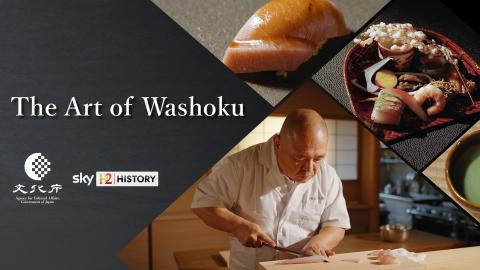The history of Saba Kaido road: Japan's ‘Mackerel Highway’
SPONSORED ARTICLE
Sky HISTORY has partnered with the Japan Ministry of Culture to bring you a series of articles that explore the history and food culture of The Saba Kaido – or 'Mackerel Highway' – a network of roads that connects Kyoto to the shimmering waters of the Wakasa Bay and the historic port town of Obama.
You’ve probably heard of the Silk Road, but do you know about the Mackerel Highway? This rather unlikely phrase refers to an ancient network of routes connecting Kyoto – that sublime city of temples, teahouses and cherry blossoms – with the nearest seaside to the north, Wakasa Obama.
Overlooking the shimmering waters of Wakasa Bay on the Sea of Japan, Obama City has attracted a fair amount of global attention since 2008, when a certain US senator blazed a trail to the White House. The shared name between the city and the former president is simply a coincidence, however, and Obama’s real claim to fame goes considerably further into the mists of time – right back to the 8th Century, in fact.
Japan’s seat of power was Kyoto, while the historic province of Wakasa, where Obama City is located, was known for its rich bounty of salt and seafood, among other culinary treasures. So much so, that it was regarded as a Miketsukuni – that is to say, a region that had the honour of providing food to the Imperial court in Kyoto. The prized ingredients were transported on foot or horseback from Obama down to Kyoto, across lush mountain passes and along picturesque river valleys. These routes would over time become known as the Saba Kaido or Mackerel Highway.
These days, literal highways make it easy to drive the roughly 45 miles between the two cities. But, before the advent of modern transportation, it was a trek that could take a day or more to complete – not the easiest of tasks when you have a basket packed with 40 kilograms of salted mackerel strapped to your back. Speed was imperative, as it was vital to transport the much-prized mackerel to the Imperial court while it was in as good a condition as possible.
The major artery of the Mackerel Highway, dubbed the Wakasa Kaido, had a number of stop-off points where weary carriers could either sit down for a much-deserved break or pass on their precious wares to Kyoto-bound colleagues. One of the most prominent stop-off points was Kumagawa-juku Post Town, which particularly flourished during the Edo Period (1603-1868) and still fascinates visitors who walk its centuries-old streets and admire the traditional townhouses.
Another older branch of the Mackerel Highway winding its way from Obama to Kyoto was called Harihatagoe. As with other parts of the Highway, contemporary hikers are drawn to the remaining stretches of the original Harihatagoe route. You can put on your walking boots and take in the spectacle of undulating mountains, dense forests, rippling streams and Buddhist temples. Not to mention, old settlements like Kaminegori, which no longer has any permanent inhabitants but whose buildings have been impeccably preserved as a monument to the region’s history.
Of course, it’s not necessary to traverse the many miles of the Mackerel Highway to get a sense of its importance to the culinary traditions of former capital city Kyoto (and, by extension, Japan as a whole). Anyone staying put in either Kyoto or Obama City will be able to taste the seafood heritage for themselves, in the form of delicacies like heshiko, which is a form of preserved mackerel that’s fermented in rice bran and salt, and saba narezushi, where heshiko is further fermented with malted rice. Another signature dish of the Wakasa region is yopparai saba, which translates as drunk mackerel. The name refers to the fact that the fish are fed sake lees, a by-product of fermenting sake, giving the mackerel flesh a more mellow and refined flavour.
The quality and popularity of the seafood is a testament to the nutrient-rich nature of Wakasa Bay, which is partly fed by water that flows down from the surrounding mountains. Speaking of geography, it’s also worth noting that, as well as being a hugely influential Miketsukuni, Obama was a significant seaport for traders bringing food products and cultural influences from the rest of Asia during the Edo Period. In other words, Obama and the wider Wakasa region became one of the great gateways to Japan, with international wares also being transported along the trails to Kyoto.
At around that time, Obama City also became renowned for its nuri-bashi, or lacquered chopsticks. These glossy and exquisite culinary implements, fashioned from wood, eggshells and seashells, are every bit as synonymous with Obama as its fishy delights. Indeed, it’s estimated that over 80% of the lacquered chopsticks in Japan originate here. The tradition stems back many centuries to an Obama-based craftsman of the early Edo Period named Matsuura Sanjuro, who is said to have been inspired by both Chinese art and by the opulent, natural mosaics of the Wakasa Bay seabed.
These prized chopsticks are just another example of just how big a role this serene corner of Japan has played in the prevailing traditions of the country, ever since intrepid traders first began to clamber their way through the thickets of the Mackerel Highway.
















